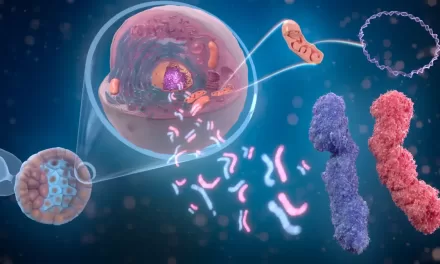Scientists are exploring gene editing as a way to correct trisomy at the cellular level.
In a groundbreaking study, researchers have successfully used CRISPR-Cas9 gene editing to remove extra copies of chromosome 21 in Down syndrome cell lines, restoring normal gene expression. This breakthrough could pave the way for future medical interventions aimed at treating the condition at its root cause.
Gene Editing for Trisomy Treatment
Down syndrome, a genetic disorder caused by an extra copy of chromosome 21, affects approximately 1 in 700 live births. Although it can be diagnosed early in development, no treatments currently exist to correct the underlying genetic anomaly. Scientists have long sought a method to address this at the cellular level, and a recent proof-of-concept study brings new hope.
Led by Ryotaro Hashizume and colleagues, researchers used the CRISPR-Cas9 gene editing system to selectively remove the additional chromosome in trisomy 21 cell lines. These cells were derived from both pluripotent stem cells and skin fibroblasts. By leveraging a precise targeting approach, the technique ensured that each edited cell retained a normal chromosomal balance, preserving one copy from each parent rather than two identical copies. Furthermore, by suppressing the cell’s natural DNA repair mechanisms, scientists increased the efficiency of chromosome removal, leading to restored normal gene expression and cellular function.
Potential for Future Medical Interventions
Although this method represents a significant scientific advancement, it is not yet ready for application in living organisms due to the risk of unintended alterations to the remaining chromosomes. However, researchers believe that refining this approach could eventually enable its use in neurons and glial cells, potentially offering a therapeutic pathway for individuals with Down syndrome.
As gene-editing technology advances, ethical and safety considerations must be carefully addressed. While this study lays the foundation for future exploration, clinical applications remain a distant goal.
Reference
“Trisomic rescue via allele-specific multiple chromosome cleavage using CRISPR-Cas9 in trisomy 21 cells” by Ryotaro Hashizume, Sachiko Wakita, Hirofumi Sawada, Shin-ichiro Takebayashi, Yasuji Kitabatake, Yoshitaka Miyagawa, Yoshifumi S. Hirokawa, Hiroshi Imai, and Hiroki Kurahashi, published on 18 February 2025 in PNAS Nexus. DOI: 10.1093/pnasnexus/pgaf022
Disclaimer
This article is for informational purposes only and does not constitute medical advice. The research discussed is in its early stages and is not yet available for clinical use. Individuals should consult with healthcare professionals for guidance on Down syndrome management and treatment options.












